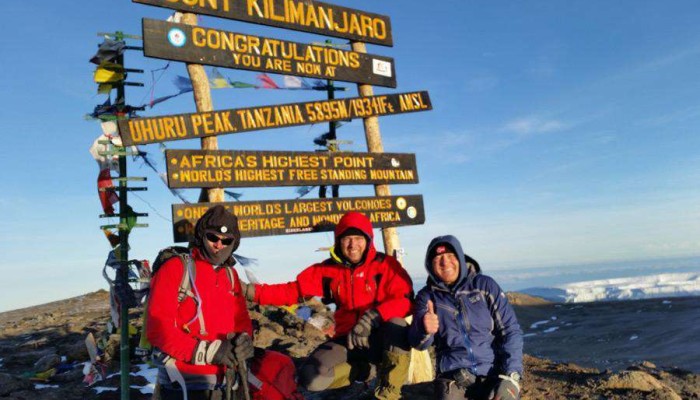
Posted by:
luck
Tour Expert
WHAT TIME OF DAY IS BEST FOR CLIMBING KILIMANJARO?
Best Time of Day for Climbing Kilimanjaro
Climbing Mount Kilimanjaro is a challenging yet rewarding experience, and the timing of your ascent can significantly impact your success and enjoyment. Here’s a detailed guide on the best time of day to tackle different parts of the climb:
General Daily Schedule
Early Morning (5:00 AM - 9:00 AM)
- Benefits:
- Cooler temperatures make hiking more comfortable.
- Clear skies often provide stunning views of the surroundings.
- Early starts allow you to cover more distance before the afternoon heat.
- Activities: Begin your daily trek, usually after a hearty breakfast. Morning hikes are less strenuous due to the cooler weather and fresh energy levels.
Late Morning to Early Afternoon (9:00 AM - 1:00 PM)
- Benefits:
- Continues the momentum from the morning session.
- Still relatively cool, but temperatures start to rise.
- Activities: Continue the trek with occasional breaks. This period is good for maintaining a steady pace.
Afternoon (1:00 PM - 4:00 PM)
- Challenges:
- Warmer temperatures can make hiking more exhausting.
- Cloud cover often increases, reducing visibility and the chance of rain.
- Activities: Take longer breaks for lunch and rest. Some guided groups might use this time for shorter hikes to acclimatize.
Late Afternoon to Evening (4:00 PM - 6:00 PM)
- Benefits:
- Cooler temperatures return, making it easier to hike.
- Preparing for camp and resting for the night’s sleep.
- Activities: Set up camp, enjoy dinner, and prepare for the next day's hike. This time is also used for short acclimatization walks, especially on acclimatization days.
Summit Night/Day
The ascent to the summit is the most critical part of the Kilimanjaro climb, typically starting around midnight to reach the summit at dawn.
Night (11:00 PM - 12:00 AM)
- Start of the Summit Push:
- Hike in the dark with headlamps, using the cold night air to your advantage.
- The terrain is usually frozen, providing better footing on scree slopes.
- Preparation: Hydrate well, dress warmly in layers, and mentally prepare for a long and challenging night.
Early Morning (12:00 AM - 6:00 AM)
- Benefits:
- Cold but stable weather conditions.
- Clear skies often provide incredible views of the stars and surrounding landscape.
- Activities: The slow and steady ascent to Uhuru Peak. Pace yourself, take regular breaks, and stay hydrated.
Sunrise (6:00 AM - 7:00 AM)
- Reaching the Summit:
- The goal is to reach the summit around sunrise.
- Witness the breathtaking sunrise over the African plains.
- Activities: Celebrate your achievement, take photos, and enjoy the views before beginning the descent.
Post-Summit Descent
Morning to Early Afternoon (7:00 AM - 1:00 PM)
- Descent:
- Descend back to base camp or further down to a lower camp.
- The descent is quicker but still challenging due to tiredness and steep terrain.
- Activities: Rest, hydrate, and eat to recover energy levels.
Tips for Climbing Kilimanjaro
- Acclimatization: Take it slow, allowing your body to acclimatize to the altitude. "Pole pole" (slowly, slowly) is the mantra for a successful climb.
- Hydration: Drink plenty of water throughout the day to stay hydrated.
- Layering: Dress in layers to adjust to changing temperatures.
- Guides and Porters: Rely on your guides for pacing and support. Porters will help carry heavy loads, so pack smart and light.
- Mental Preparation: Stay positive and mentally prepared for the challenge, especially on summit night.
By starting early each day, pacing yourself, and strategically timing the summit push, you can maximize your chances of successfully reaching the top of Mount Kilimanjaro and enjoying the experience to the fullest.
Need something more ...?
View by Tags
- Adventure Serengeti Balloon Safaris
- Honeymoon Serengeti Honeymoon Safaris
- Tanzania safaris Serengeti Safaris in Tanzania
- Adventure SUGGESTIONS FOR SAFARI?
- Culture THE WEATHER IN TANZANIA
- Nature TRAVEL ADVICE
- Trek WHAT TIME OF DAY IS BEST FOR CLIMBING KILIMANJARO?
- Safari When is the best time to park on a Tanzania safari?
- Bigfive Where in Tanzania can I witness migration and the Big Five?
- Beach ZANZIBAR POPULARITY